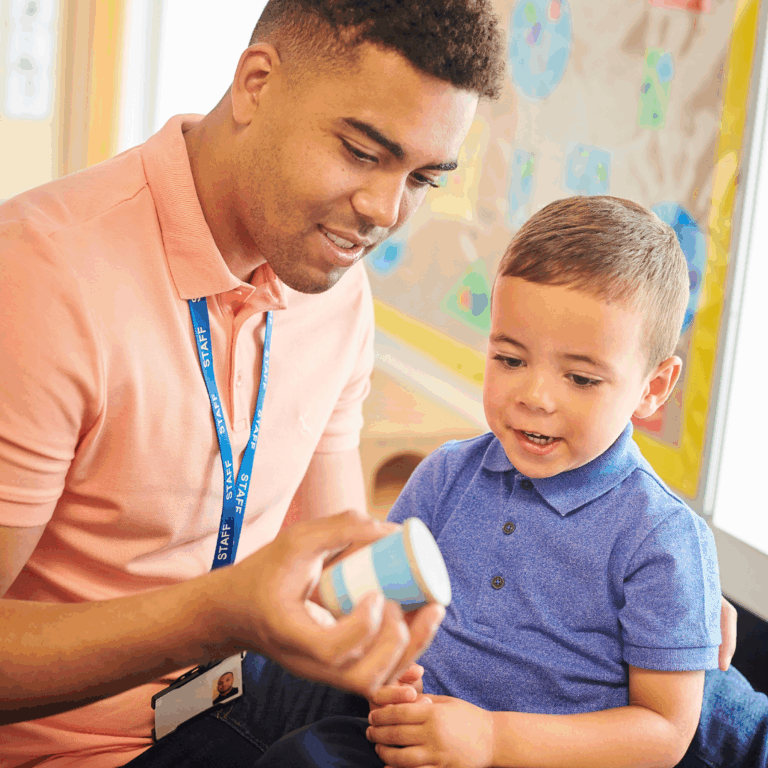Working hours
Mon - Fri: 8am to 5pm
Mon - Fri: 8am to 5pm
Share

Why is it still such a surprise to see a man working in a nursery setting?
Despite the strides we’ve made in promoting gender equality, the early years sector continues to be one of the most gender-skewed professions in the UK. With men making up just a small percentage of the workforce, many children will go through their formative years without ever experiencing care or education from a male role model.
We believe that this imbalance isn’t just a recruitment issue – it’s a mindset issue. Parental perceptions play a huge role in shaping the environment male educators step into, often creating invisible barriers before a candidate has even stepped through the door.
Challenging these perceptions is about more than simply increasing numbers – it’s about helping families, children, and educators alike to embrace the richness that comes from a gender-diverse team. After all, if we want our children to grow up in a world that values inclusion, shouldn’t they see it reflected from their very first classroom?

Let’s be honest — when parents raise an eyebrow at the idea of a male early years educator, it’s rarely coming from a place of hostility. More often than not, it’s rooted in fear, societal conditioning, or simply a lack of familiarity. But those perceptions, even when unspoken, can have a powerful impact.
Some of the most common concerns we hear relate to safeguarding — often fuelled by media reports that sensationalise rare cases and, in doing so, unfairly cast doubt over an entire gender. When I was setting up Male Childcare and Teaching Jobs 4 years ago, I was honestly baffled by how often negative safeguarding episodes dominated the top of online search results when simply researching the topic of men in early years. It was disheartening to see that this is still the first association many people might come across – reinforcing stigma rather than celebrating the brilliant work so many male educators do every day.

Others assume that men are better suited to discipline rather than nurturing roles, or that they lack the emotional sensitivity required to care for young children.
These assumptions don’t come out of nowhere. They’re shaped by decades of gender stereotypes – from childhood toys to TV shows – where men are problem-solvers and protectors, not carers and comforters.
But just because a perception is common doesn’t mean it’s correct. And just because it’s not always said aloud doesn’t mean it isn’t felt. That’s why it’s so important we start having open, honest conversations – not to point fingers, but to help shift outdated beliefs and shine a light on what men in early years really bring to the table.
When we talk about the value of men in early years, we’re not talking about ticking a diversity box – we’re talking about enriching the experiences children have during their most crucial developmental years.

Research continues to show that children benefit from having access to a range of role models, including those who reflect different genders, cultures, and backgrounds. When children see both men and women showing kindness, empathy, and care, it helps to break down outdated stereotypes and broadens their understanding of the world around them.
Male educators bring a wealth of strengths – from emotional intelligence and playful engagement to different communication styles and fresh perspectives. We’ve seen countless examples of this in action: from a male practitioner leading an outdoor forest play session with infectious enthusiasm, to another hosting a storytelling circle that had every child hanging on his every word. These are not exceptions – they are everyday moments that challenge assumptions and create impact.
When we limit who children see in caring roles, we unintentionally limit their expectations of who they – and others – can become. But when we welcome diversity into our settings, we open the door to a more inclusive, balanced, and inspiring learning environment for everyone.
If we want to shift parental perceptions, we can’t just rely on hope – we need to be intentional in how we present, promote, and celebrate gender diversity within our early years settings.
It starts with the messages we put out. Whether it’s on our websites, brochures, or social media pages, let’s make sure our imagery and language reflect an inclusive workforce. If we only ever showcase women in nurturing roles, we’re reinforcing the very stereotypes we’re trying to dismantle.

I’ve come across some wonderful examples from large nursery groups who have created dedicated sections on their websites to highlight their commitment to the inclusion of men in early years. This sends a powerful message to prospective parents – it shows that gender diversity is not an afterthought, but a core value. It also means parents are more likely to be familiar with this approach before even signing up, helping to prevent any surprises and reducing the risk of unconscious bias or discrimination later on.
I’d strongly encourage smaller groups and independent settings to consider doing the same. Even a simple webpage or blog post about your commitment to gender inclusivity can have a positive ripple effect within your local community, helping to normalise the presence of male educators and celebrate the value they bring to the team.
Parent inductions also offer a great opportunity to set the tone. Introducing staff with confidence – not defensiveness – goes a long way. A simple, positive introduction to male educators, including a bit about their background and what they bring to the team, can help put parents at ease from day one.
Social media is another powerful tool. Sharing stories about our male educators – their journeys into the sector, their day-to-day interactions, the joy they bring to their role – helps normalise their presence and humanise their work.

We’ve also seen the power of inviting parents into sessions led by male educators. Whether it’s a cooking activity, music group or forest play session, seeing the warmth and professionalism first-hand often speaks louder than any policy document.
And let’s not forget the value of parent testimonials. Hearing another mum or dad say, “My child adores their male key person,” can do wonders for breaking down barriers. One conversation at a time, one story at a time – this is how we change the narrative.

While leadership teams play a key role in shaping perceptions, there’s also a lot male educators can do on a day-to-day basis to build trust and rapport with families.
Visibility makes a big difference. Being present at drop-offs and pick-ups, greeting parents with a warm smile, and engaging in those casual, everyday conversations helps form genuine connections. These small moments often leave a lasting impression.
Communication style matters too. Approaching families in an open, friendly and collaborative way – whether it’s sharing updates about a child’s day or discussing their development – helps to build a strong foundation of mutual respect. It’s about showing families that we’re on the same team.
We’ve also seen the positive impact of celebrating shared milestones. Whether it’s a Father’s Day breakfast, a storytelling session led by a male practitioner, or a cooking activity with dads and carers, these moments create meaningful memories and show parents the joy and impact of male involvement.
Building trust doesn’t happen overnight – but through consistency, visibility and authentic connection, male educators can help reshape perceptions, one relationship at a time.
Challenging perceptions isn’t just the responsibility of male educators – it’s something we all need to play a part in. As nursery leaders, practitioners, and parents, we each hold the power to reflect on our own unconscious biases and how they might shape the messages we send, even unintentionally.
Diversity in early years settings isn’t a nice-to-have – it’s essential for helping children grow up in a world that values fairness, empathy, and inclusion. When children see care, comfort, and play coming from people of all genders, it broadens their understanding of what’s possible – for themselves and for others.
Challenging assumptions about men in early years education isn’t just a side conversation – it’s a crucial part of building a more inclusive, balanced, and enriching environment for all children.
Small shifts in mindset can lead to big changes in culture. By welcoming, supporting, and celebrating male educators, we’re not adding a “bonus” – we’re strengthening the profession.
Together, we can shape a sector where care knows no gender.
Claudio Sisera is Head of Diversity and Inclusion at Male Childcare & Teaching Jobs.

With the ever-changing regulations and guidance, sign up to our monthly newsletter and mailings to stay current and keep up to date with running your childcare setting.
Simply enter your details below to join our mailing list.
By completing this form you are agreeing to our privacy policy You can unsubscribe at any time
